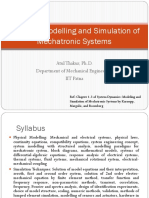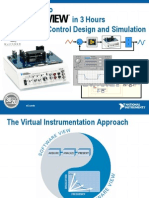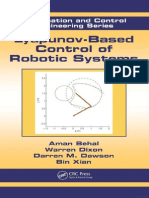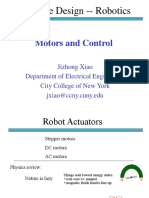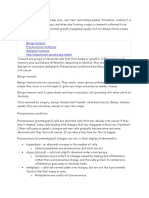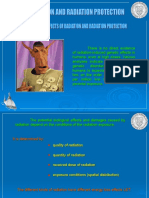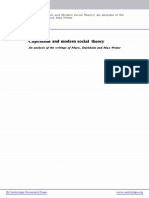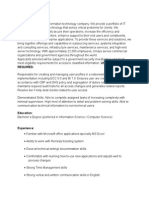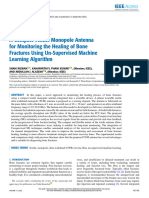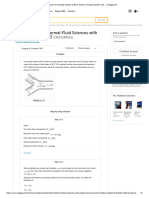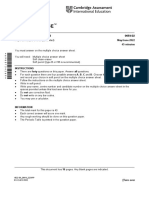NPTEL >> Mechanical Engineering >> Modeling and Control of Dynamic electro-Mechanical System
Module 1- Lecture 1
Introduction to Dynamic System Modelling
Dr. Bishakh Bhattacharya Professor, Department of Mechanical Engineering IIT Kanpur
Joint Initiative of IITs and IISc - Funded by MHRD
�NPTEL >> Mechanical Engineering >> Modeling and Control of Dynamic electro-Mechanical System
Module 1- Lecture 1
TheLectureContains
Introduces d afew f Controlled ll dDynamical lSystems Modelling gofaDynamical y System y PresentstwoDynamicSystemsforMathematical Modelingnamely: ACruiseControlSystem ADiskReadingSystem
Joint Initiative of IITs and IISc - Funded by MHRD
�NPTEL >> Mechanical Engineering >> Modeling and Control of Dynamic electro-Mechanical System
Module 1- Lecture 1
Course Introduction
Electro-mechanical systems are ubiquitous today. Starting from an Intelligent W hi Machine Washing M hi that th t determines d t i washing hi span of f garments t on its it own to t Rockets and Un-manned Vehicles that determines its course of flight autonomously our world is full of such autonomous dynamic systems today. Due to the mind boggling variety of such examples that we come across a systems approach is highly needed to understand the nature of such systems and predict dynamic response. In order to design and develop an autonomous system, you need to have knowledge g of two fundamental subjects j dynamical y systems y and feedback control. While, the first helps you in terms of understanding the response of the system under various mechanical and electrical inputs; the knowledge of feedback control helps you to develop autonomous systems that can follow a set of desired commands or g generate a desired response p or output. p In this lecture, I will give you the glimpses of an array of applications in which we have applied this concept. This will help you to understand where you can possibly apply the knowledge that you will acquire in this field
JointInitiativeofIITsandIISc Fundedby MHRD
�NPTEL >> Mechanical Engineering >> Modeling and Control of Dynamic electro-Mechanical System
Module 1- Lecture 1
EXAMPLE 1: Next Generation: Controllable Antenna
AntennawithMuscleWire
DeformedAntennaafter triggeringtheMuscleWires
Shape of an antenna could be controlled by controlling the tension in the muscle wires. Muscle wires made of Shape Memory Alloy (SMA) gets shortened if heated y electricity. y In this p process, an wire of diameter 350 micrometer could g generate by force up to 10N. Using this technology, one can control the transmission pattern from an antenna
JointInitiativeofIITsandIISc FundedbyMHRD 4
�NPTEL >> Mechanical Engineering >> Modeling and Control of Dynamic electro-Mechanical System
Module 1- Lecture 1
A Beam Deformation by SMA Wire
Note:AswepasscurrentintotheSMAwire wire,duetophase transformationitgetsshortenedwhichwillproduceacoupleon thestiffenerbeamandbendit.Bycontrollingthecurrentinthe SMAwire youcancontrolthisbending.
JointInitiativeofIITsandIISc Fundedby MHRD
�NPTEL >> Mechanical Engineering >> Modeling and Control of Dynamic electro-Mechanical System
Module 1- Lecture 1
SchematicoftheControllableAntennaSystem
AnalogtoDigitalConversion
Note:Inthissystemtherearetwosensors:(a)StrainGauge Sensor(usedforsensingthestrainwhichcanbeconvertedto deflectionand(b)LaserDisplacementSensor(OptoNCDT);the ,whichcanbeclassifiedas musclewiresareFlexinolSMA, actuators.
Joint Initiative of IITs and IISc - Funded by MHRD
�NPTEL >> Mechanical Engineering >> Modeling and Control of Dynamic electro-Mechanical System
Module 1- Lecture 1
EXAMPLE2:SatelliteUltraquietIsolationTechnologyExperiment(SUITE)
Considerthetoppartdesignedforvibrationisolation
Satellitehasahighlysensitivepayload,whichmustbe savedfromtremendousvibrationthatgetsgeneratedina satellite t llit launching l hi vehicle. hi l Vibration Vib ti i isolators l t areused d f for thispurpose.
Joint Initiative of IITs and IISc - Funded by MHRD
�NPTEL >> Mechanical Engineering >> Modeling and Control of Dynamic electro-Mechanical System
Module 1- Lecture 1
Detailed Description p of the Vibration Isolator
Onesuch hisolator l isk knownas ActiveStewartPlatform Here, ,theisolationisachieved bycontrollingtheleglengths ofsixlinkswiththehelpof piezoelectricactuators
JointInitiativeofIITsandIISc FundedbyMHRD
�NPTEL >> Mechanical Engineering >> Modeling and Control of Dynamic electro-Mechanical System
Module 1- Lecture 1
EXAMPLE3:ADrugInfusionControlSystem
An autonomous drug infusion control system could solve a very challenging problem of hospitals of our country where the number of nurses are too few in comparison to the number of patients. This system is envisaged to control the flow of various drugs and nutrients to patients body autonomously and send an warning to the nurse when the supply gets over..
Joint Initiative of IITs and IISc - Funded by MHRD
�NPTEL >> Mechanical Engineering >> Modeling and Control of Dynamic electro-Mechanical System
Module 1- Lecture 1
ConceptDetailingofaSmartDrugInfusionSystem
Thechallengeofthisproject istodesignasmart intravenousdruginfusion systemfreefromroller clampwithhighvisibility medicinelevelindicatorsand soundindicatorswhichcan beeasilyoperatedwith remotecontrol l
Thisisanovelconceptinwhichessentiallyflowfromatubeiscontrolledwiththehelp of fanmicro i actuator(shown (h asagreencompliant li system). ) The h systemis i controlled ll d usingwirelesscommunication.
Joint Initiative of IITs and IISc - Funded by MHRD
�NPTEL >> Mechanical Engineering >> Modeling and Control of Dynamic electro-Mechanical System
Module 1- Lecture 1
AC Closer ose look oo of o the t e Compliant Co p a t Mechanism ec a s
JointInitiativeofIITsandIISc Fundedby MHRD
11
�NPTEL >> Mechanical Engineering >> Modeling and Control of Dynamic electro-Mechanical System
Module 1- Lecture 1
Did d you notice ot ce a Co Common o Pattern? atte
Inalltheseexamples,thestructures DynamicalSystemslikeAntenna,Isolatorand DrugInfusionSystemarecontrolledbytheActuatorsbaseduponcommandsfrom th Control the C t lSystem S t which hi hhas h taken t k decisions d i i based b donanarrayof fSensors. S
JointInitiativeofIITsandIISc FundedbyMHRD 12
�NPTEL >> Mechanical Engineering >> Modeling and Control of Dynamic electro-Mechanical System
Module 1- Lecture 1
ModellingaDynamicalSystem
Models are mathematical representations of system dynamics Models allow the dynamics to be simulated and analyzed, without physically building the system. Models are simplified form of the system and hence are never exact! Models can be used in describing the ways in which a system can perform. Certain types of analysis (e.g., parametric variations) cant easily be done on the h actual l system b but can b be simulated i l d through h h system models d l Models can be run much more quickly & thus saves developmental time A single system may have many models
Joint Initiative of IITs and IISc - Funded by MHRD
�NPTEL >> Mechanical Engineering >> Modeling and Control of Dynamic electro-Mechanical System
Module 1- Lecture 1
Choice of inputs and outputs depends on point of view
Inputs: These are the parameters that are external to the model that you are building Inputs in one model might be outputs of another model (e.g., output of an antenna controller provides input to the antenna model) Outputs: Physical variables (often states) that one can measure Choice of outputs depends on what we intend to sense and what parts of the component model interact with other component models States: Chosen such that their values at a reference time and the corresponding inputs are known. May or may not include Outputs.
Joint Initiative of IITs and IISc - Funded by MHRD
�NPTEL >> Mechanical Engineering >> Modeling and Control of Dynamic electro-Mechanical System
Module 1- Lecture 1
Assumptions p in a Model
There are two types of assumptions implicit and explicit assumption Implicit assumptions are generally universally known and hence rarely stated for example, use of continuum model , earth as inertial reference frame etc. Explicit assumptions are stated in the beginning of establishing a mathematical relationship. In this course we will explicitly assume that the dynamic systems to be modelled are Linear and Time Invariant (LTIV) in nature. In simple terms, this would imply that the dynamic systems will be modelled as a set of ordinary differential equations (neglecting the non-linear effects) and also the coefficients in such governing equations are constant.
JointInitiativeofIITsandIISc FundedbyMHRD
15
�NPTEL >> Mechanical Engineering >> Modeling and Control of Dynamic electro-Mechanical System
Module 1- Lecture 1
A syste system is s modeled ode ed e either t e by defining the input-output characteristics or by selecting a set of state variables
Inputs describe the external excitation of the dynamics . Inputs are extrinsic t i i to t the th system t dynamics d i ( (externally t ll specified) ifi d) . C Constant t t inputs are often considered to be parameters Outputs p are variables that are to be calculated or measured Input-output relation is often governed by a generalized ODE of the form any(n)+..+a2y(2)+a1y(1)+aoy=bmu(m)+.+b1u(1)+bou(t) Where y(n)= dny/dt /dtn, u(m)=d(m)u/dt /dtm
Joint Initiative of IITs and IISc - Funded by MHRD
�NPTEL >> Mechanical Engineering >> Modeling and Control of Dynamic electro-Mechanical System
Module 1- Lecture 1
ConsideraCruiseControlModel:
The car above is travelling at a speed u. Neglecting excitations due to road undulations etc. can y you find out the g governing g Equation of Motion (EOM)? Can you find out the input-output relationship from the EOM?
Joint Initiative of IITs and IISc - Funded by MHRD
�NPTEL >> Mechanical Engineering >> Modeling and Control of Dynamic electro-Mechanical System
Module 1- Lecture 1
ConsidertheDiskReadingSystem
Non-collocated sensing
Can you find out the Governing Equation of Motion? Can you find out the relationship between the Torque and Angular Displacement?
Joint Initiative of IITs and IISc - Funded by MHRD
�NPTEL >> Mechanical Engineering >> Modeling and Control of Dynamic electro-Mechanical System
Module 1- Lecture 1
GeneralReferenceBooks FeedbackControlofDynamicSystems Franklin,PowellandNaeini, PearsonEducationAsia AdvancedControlSystems DorfandBishop,PearsonEducationAsia ControlSystemsEngineering NormanSNise,JohnWiley&Sons ModernControlEngineering K.Ogata,PrenticeHall Mechatronics:ElectronicControlSystemsinMechanicalandElectrical Engineering W.Bolton,PrenticeHall Handbookof fSensorsandActuators Elsevier,serieseditor:P.P.Regtien
JointInitiativeofIITsandIISc FundedbyMHRD

